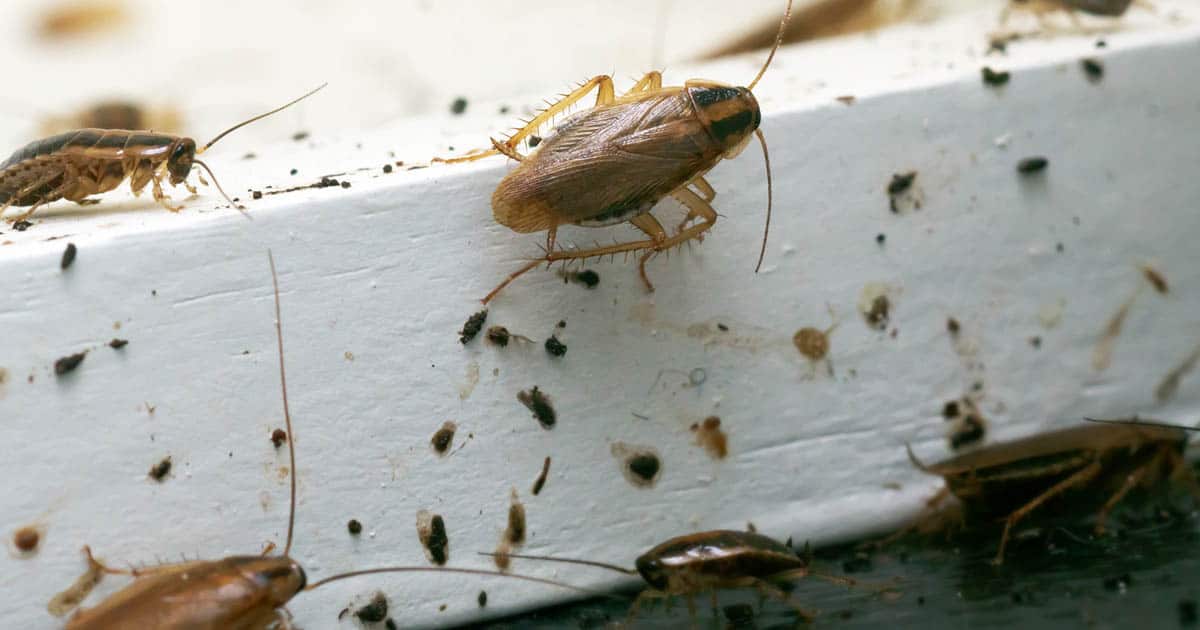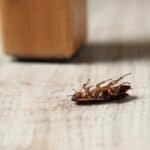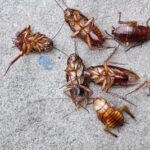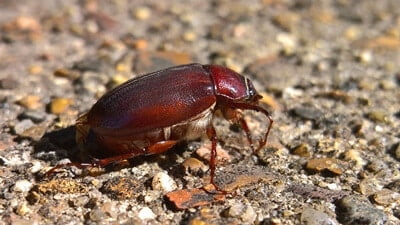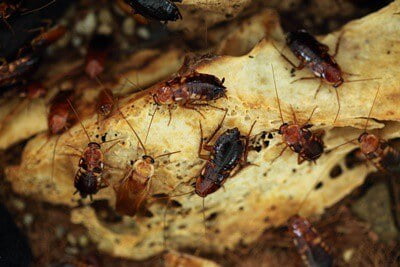Cockroaches are notoriously hardy. They can eat almost anything and live in harsh conditions. Despite this, finding cockroaches in a UK home often causes shock and dismay. These creatures are often thought to be restricted to the European continent and America. This isn’t the case as there are cockroaches in the UK.
Cockroaches aren’t very common in the UK. Of the 3,000+ species in the world, only 4 are commonly found in Scotland, England, Wales, and Northern Ireland. The German, oriental, American, and brown banded cockroach can all be found in the United Kingdom.
Due to the often harsh and cold weather, their population is limited. UK cockroaches prefer to be inside rather than in exterior habitats, like leaf piles and garbage disposal sites. There are also a number of insects in the UK that can be mistaken for cockroaches, including wood-boring beetles and woodlice (slaters).
Are Cockroaches Native to the UK?
There are 3 species of cockroach that are considered native to the UK. However, these species are not found in Ireland or Northern Ireland. These are as follows:
- Tawny cockroach
- Dusky cockroach
- Lesser cockroach
These species are not pests, however, and are found outside in their natural habitats in Southern England and Wales. The last, in particular, is localized to coastal areas. Other cockroach species that are more commonly found infesting properties in the UK, however. These are the:
- German cockroach
- American cockroach
- Oriental
- Cockroach
- Brown banded cockroach
These are not native to any of the UK’s 4 countries. Such cockroaches are considered pests and are invasive species that only thrive in human habitats like:
- Attics
- Basements
- Abandoned or poorly maintained properties
Of these 4 species, the American cockroach is the least common in the UK.
UK Cockroach Species
The wild cockroach species that are native to the southern parts of the UK are far smaller than the pest species. Such types are commonly found in heated greenhouses or in residential and commercial properties.
The tawny cockroach, for example, tends to be 10 mm in size when fully grown. Meanwhile, the dusky cockroach tends to have an average size of 10.5 mm in size. This is very small when compared to the 30 mm average size of certain pest species.
German Cockroaches
The German cockroach is one of the most prolific across the UK. According to the Journal of Environmental Health, they are so common, in fact, that there are a number of studies concerning products that can be used to remove and prevent infestations.
German cockroaches average at 13 to 16 mm in size and have a long, pale brown body with two dark stripes behind their head. They have a lifespan of around 12 months and lay more eggs than the other UK species.
These cockroaches are very common worldwide, and are quite hardy. They prefer wet and humid environments, and are nocturnal (as all cockroaches are). They prefer to eat scraps of food matter, but can also eat other organic material. German cockroaches cannot fly.
Oriental Cockroaches
Oriental cockroaches are arguably the second most common roach species found across the UK. They are also the second biggest roach found in UK homes, outbuildings, and commercial premises.
The average size of a female Oriental cockroach is 32 mm. Meanwhile, a male averages at 25 mm. As such, they are considerably larger than all native cockroach species.
Oriental cockroaches are a uniform black or dark brown in color and have a larger, rounded head. Both the male and female of this species are incapable of flight, and they have a relatively short life span of 6 months.
They feed primarily on decaying or rotting organic matter, but they are omnivorous (as all cockroaches are). This means they will eat anything they can find, particularly if their preferred food is in short supply.
American Cockroaches
American cockroaches are the least commonly found across the UK. Their presence is almost entirely limited to southern areas, thanks to their relatively low tolerance for cold.
With an average size of 53 mm, they are the largest species of cockroach found in the UK. Because of their unusual size and reddish-brown color, they are highly distinctive and easy to recognize.
American cockroaches also have light yellow bands around the shield behind their heads. Both the male and female members of the species have wings and are capable of using them to glide.
With a lifespan of 2 years, they are fairly long-lived and prefer warmer environments that have food stores. This means they are most likely to be found in residential properties and kitchens.
Brown Banded Cockroaches
Brown banded cockroaches are the smallest invasive cockroach species found in the UK. Males have a distinctive, dark brown coloring that lightens to a yellowish hue further down their wings. Meanwhile, females are reddish-brown in color.
Both males and females have two light yellow bands across their bodies. Only male brown banded cockroaches are capable of flight, but both males and females may jump when disturbed.
With an average lifespan of 3 to 11 months, these cockroaches can have quite short lives, but they are prolific breeders. They prefer warm, humid habitats. They have even been known to take up residence inside electronic appliances like fridges.
Brown banded roaches prefer to eat food scraps. Nonetheless, they will eat decaying organic matter when food is hard or impossible to access.
Flying Cockroaches
It is a common misconception that there are many flying cockroaches in the UK. While the American cockroach has wings, for example, they generally glide rather than fly. They cannot remain airborne for long. Likewise, German and oriental cockroaches are incapable of flight.
The only UK cockroach that can actually fly is the brown banded cockroach. However, it is only the male of the species that can do this.
Species of cockroach that are known for being adept at flying are the Asian, smoky brown, and Australian species of cockroach. These species are not found in the UK.
As such, if you think you have flying roaches in your home, it is likely that they are male brown banded cockroaches. Alternatively, they are another form of insect that is similar to a cockroach in appearance.
How Many Cockroaches Are in the UK?
The number of cockroaches (and infestations) active in the UK at any given time fluctuates dramatically. In fact, BPCA statistics show that between 2010 and 2016, cockroach callouts consistently decreased from over 17,000 to just under 6,000 per year. However, this decrease is largely due to concerted efforts to decrease infestations in large cities in England. In 2016, 5,353 of the 5,904 callouts were placed in England.
In Scotland, Northern Ireland, and Wales, however, the number of callouts about cockroach infestations fluctuates up and down on a yearly basis. This is likely to be because of climactic facets, as well as social issues within the areas where the cockroach infestations are localized.
In all cases, however, Northern Ireland has the lowest number of cockroaches and infestations. This may be because the climate is generally inhospitable to them.
Pest cockroach species are far more common in large cities like London, Cardiff, Edinburgh, and Belfast than they are in rural areas. This is because there is a far bigger pool of potential habitats for invasive cockroach species in urban environments. Likewise, they generally cannot survive in the natural environment offered by the UK nations.
Are There Cockroaches in England?
There are cockroaches in England. In fact, southern England is where cockroaches in the UK are most populous, both as pests and native wildlife.
First and foremost, this is because the south of England is generally the warmest part of the UK at any given time. Secondly, England has the highest population density in the UK. The majority of the large cities in the United Kingdom are concentrated in the south of England.
As a result, many of the top 10 places for cockroach infestation reports are in or around the greater London area. This is with the exception of certain parts of Glasgow, which have experienced rising numbers. This is most likely the result of increasingly warm summers over the last decade or so.
It may also be due to the number of student housing buildings. According to another study from the Journal of Environmental Health, they are more likely to experience infestation.
As well as being the hotspot for invasive cockroach species, the southern areas of England are also home to the largest numbers of native, wild species of cockroach.
Do Cockroaches Live in Wales?
Both native and invasive species of cockroach are found in Wales. In particular, they are in south Wales, where there are native species found in the coastal areas.
In terms of invasive species, however, Wales tends to switch between 2nd and 3rd place when it comes to the number of infestations reported.
Fluctuations in the cockroach population of Wales are likely to be a result of changing climatic conditions. That’s matched to concerted local efforts to clamp down on hotspots in urban areas.
Are Cockroaches Common in Scotland?
There are cockroaches in Scotland, but they are exclusively invasive species. The cockroaches that are native to some parts of the UK cannot live in the natural environment in Scotland. Despite this, Scotland tends to have either the 2nd or 3rd highest rate of cockroach infestation reporting in the UK as a whole (tied with Wales).
The cockroaches that are most common in Scotland are the German and oriental cockroach species. According to Entomological Experimentation and Application, oriental cockroaches in particular have a relatively high tolerance for cold. This accounts for their proportionally higher population in Scotland.
Can You Get Cockroaches in Northern Ireland?
Cockroaches are incredibly uncommon in Northern Ireland. There are no native species of cockroach that can be found in Northern Ireland, and few invasive species ever take root there. In comparison to over 5,000 yearly reports in England in the year 2015–2016, Northern Ireland had less than 80.
As in Scotland, German and oriental cockroaches are the most likely to be found in Northern Ireland. American cockroaches are almost never found in Northern Ireland or Scotland. Likewise, brown banded cockroaches are incredibly rare.
Does the UK Have Roaches?
As stated, the UK does have cockroach species, both invasive and native. However, cockroaches are incredibly rare, even in large cities in the south of England. The callout rate for cockroach infestation is generally below 0.20 per 1,000 persons, even in the Greater London area where they are most common. As such, most of the cockroach sightings in the UK turn out to be other bugs and insects.
While the large, red-brown American cockroach is incredibly distinctive, the other species of cockroach that are commonly found in the UK are easy to mistake for other insects.
This is particularly likely if they can fly or if they have elongated, dark brown or black bodies. There are many native species of beetle and louse in particular that may be mistaken for cockroaches by those who have limited experience or knowledge of them.
Bugs That Look Like Cockroaches in the UK
Many native UK bugs can be mistaken for cockroaches, particularly brown banded or German cockroaches. Not all of these bugs are found throughout the UK. Just as certain cockroach species are localized, their doppelgangers can also be localized to certain areas. The bugs most commonly mistaken for cockroaches include:
- Wood lice (slaters)
- Crickets (found only in southern England)
- Bread beetles
- Bed bugs
- Vine weevil (imported in contaminated wood)
- Deathwatch beetle (found in southern England)
- Carpet beetle
- Two spot carpet beetle (found in South England and Wales)
- Brown carpet beetle (mostly found in London)
Beetles are types of insects most likely to be mistaken for cockroaches because of their body shape and coloring. Many beetles are, after all, black, reddish brown, or brownish yellow in color. Some even fly, which can make them frightening and thereby obfuscate proper and correct identification.
Why Have I Got Cockroaches In My House?
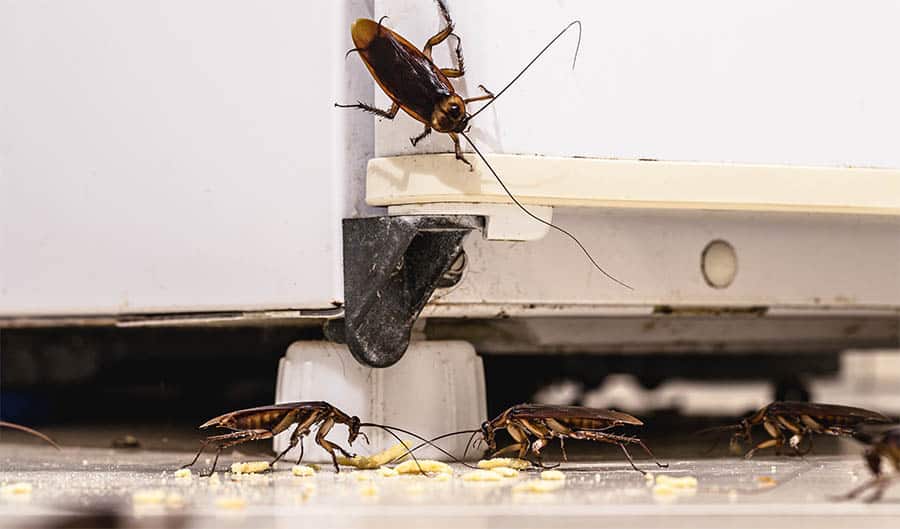
It is a common misconception that cockroaches are only found in excessively dirty homes. While it is true that dirty or cluttered homes are more likely to experience infestations, it’s possible for them to take root in clean homes. So, if your home is clean and tidy, but you still see signs of cockroach infestation, a number of other factors could be at work.
Like all animals, cockroaches need food, water, and appropriate shelter in order to survive. Most species of cockroach prefer warmer, humid climates, which makes them less common in very cold places. It is also why invasive cockroach species are found inside properties, both commercial and residential. They tend to congregate in quiet, dark places where they have access to water and appropriate food sources.
Therefore, you might find that you have cockroaches in your home simply because they have found:
- Warmth
- A quiet place to spend the daylight hours
- Enough moisture
- A viable food source
Depending on the species of cockroach, this could mean food scraps, crumbs, or decaying organic matter like wood, cardboard, and cloth. The most common infestation sites are:
- Attics
- Kitchens
- Seasonal storage areas
- Wall interiors
A leaking pipe or appliance, for example, can create the perfect environment for cockroaches to take up residence. Once they have set down roots, cockroaches can be incredibly difficult to get rid of. As such, it is far better to prevent infestations from getting started in the first place.
How Do I Prevent Cockroach Infestation?
Once you have cockroaches in your home, it is hard to get rid of them. This is why you should do all you can to stop them from making a home for themselves on your property. There are 5 main things that you can do to prevent infestation, the first of which is to ensure that your home is as clean as it can be. This means keeping your home free of food debris, trash, and organic debris.
Secondly, you should keep your home as free of clutter as possible. Cockroaches love to find dark, secluded places to create their nests in. This is why it is important to minimize available nesting sites. Minimizing clutter will also make it easier to spot them if they do move into your property at some point.
Thirdly, you should do your utmost to minimize and block potential entry points. For example, gaps between tiles, utility entry holes, and small crevices should be blocked with sealant. Larger gaps and holes can be filled with something robust enough to keep cockroaches out. Steel wool or insulation foam, for example, can do the trick very nicely.
Finally, you should fix any leaks you discover immediately. This will minimize the chances that invasive cockroach species will find your home attractive and decide to try to move in. To this end, you should check behind appliances under your kitchen and bathroom sinks, as well as behind your toilet, for signs of dampness. Do this on a regular basis and act quickly when you see moisture.
How to Get Rid of Cockroaches in the House?
So, despite your best efforts, you have found cockroaches inside your home. At this point, a number of paths should be taken. First and foremost, you should clean up debris, droppings, carcasses, and any organic matter that makes it easier for cockroaches to live in your home. You should also attempt to kill any roaches that you see within your home.
While there are many specialized products designed to do this, an ideal option is liquid soap and water. By creating this soapy solution, you can kill roaches in an eco-friendly manner. It does this by coating the cockroaches’ breathing pores with a soapy film, essentially suffocating them. You can also use sticky traps or borax powder.
Whatever you use to kill the cockroaches in your home, you must follow up with an investigation. Follow the trail of droppings and carcasses to the nest, if you can, and begin the process of removing the strongholds. You can do this with baking soda, bleach, and any other anti-bacterial cleaning products. If they have set up behind an appliance such as a refrigerator, you may also need to open up the appliance to clean it out.
This may seem drastic, but it is very common for cockroaches to exist and live inside of appliances that have motors because they create warmth. If you are concerned about the state of the appliances in your home, you can have a professional inspect and clean them. This may have the added benefit of improving the function and efficiency of your appliances.
Of course, the most convenient and effective way to remove cockroach infestations is to call in pest control specialists. Professionals have all of the tools and products that they need to make removal more effective and efficient. This is a more costly option, but it will ensure success the first time around. It will also minimize the risks to your health and wellbeing posed by dealing with cockroaches.
Keeping Cockroaches Out After Removal
Once they have been ousted from your home, there is a chance that cockroaches will return. This is especially likely when the underlying conditions that make it possible for them to thrive are not dealt with. Fixing leaks, plugging gaps, and maintaining cleanliness is key for preventing recurrence when it comes to infestations.
You can also repel future investigations with the use of essential oils or even some citrus extract in the water you mop your floors with. Citrus may smell wonderfully attractive to us, but cockroaches find it repulsive and will avoid homes that make liberal use of it. Spreading baking soda under appliances and in areas that are attractive to cockroaches will make short work of any that invade your home in search of shelter.
